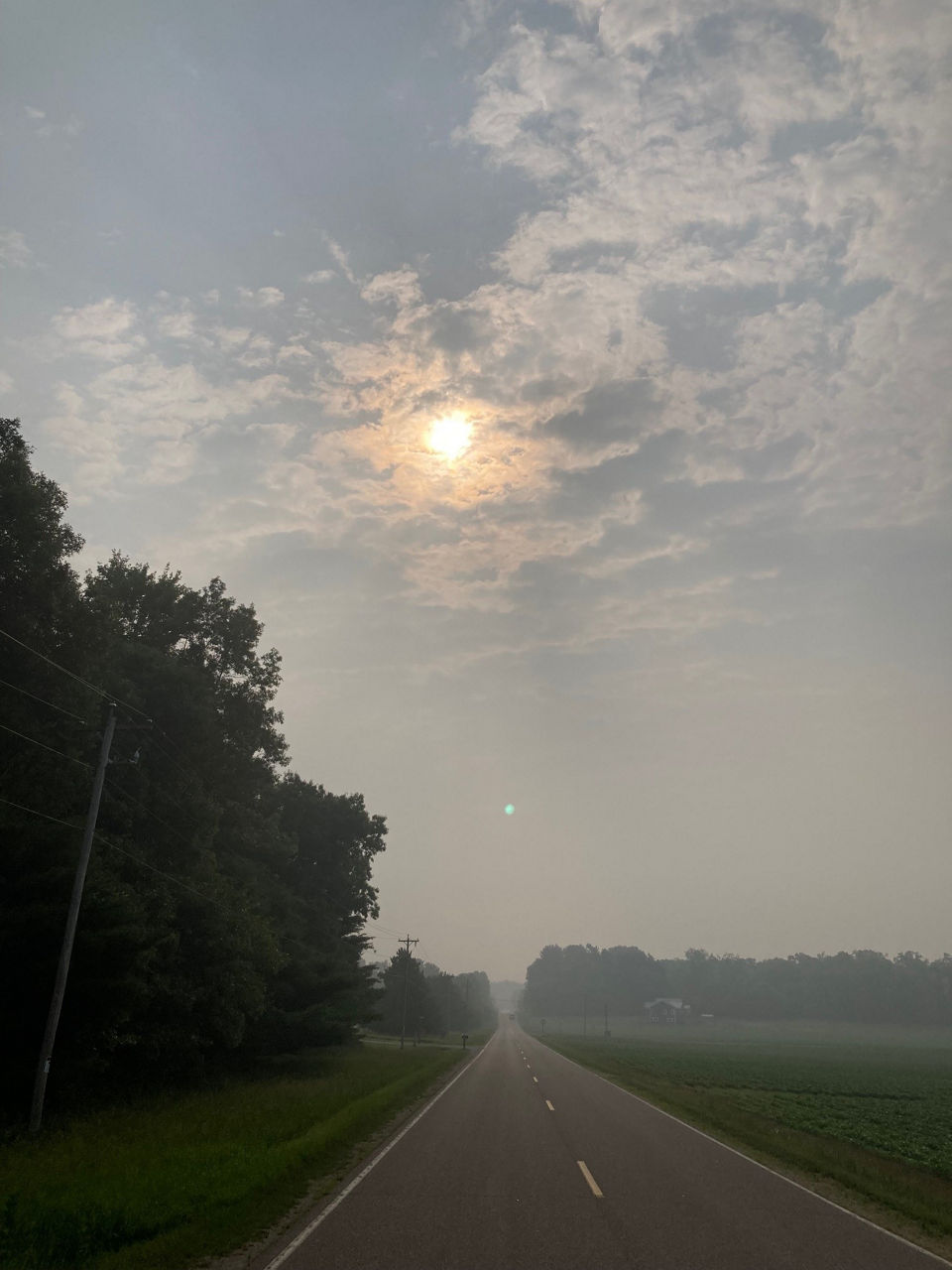What Is the Effect of Wildfire Smoke on Crops?
June 29, 2023
Smoke from Canadian wildfires has been impacting North America for over a month. The question on the minds of many farmers and agronomists is, what is the impact of the smoke on growing crops?

How is the smoke impacting plants?
Atmospheric smoke may reduce the amount of solar radiation in a way similar to cloud cover. The reduction in solar radiation may impact certain plants more than others. Many warm-season grasses, such as corn and sorghum, fix carbon using the C4 photosynthesis process. When solar radiation is reduced, C4 plants can be impacted to a greater degree than plants that photosynthesize using the C3 pathway, such as soybean and wheat.
Particles and gasses in the atmosphere absorb and scatter light as it enters the atmosphere, making the light more diffuse. This is particularly true for blue light, which has a very short wavelength. Blue light and red light can increase the photosynthetic capacity of corn. Thus, atmospheric smoke may increase the scattering and diffusion of shorter-wavelength blue light, making it more available to plants. This potentially provides a boost in photosynthesis if enough total solar radiation filters through the smoke.


Figure 2. Smoke over Pine River, Wisconsin, June 28, 2023.
Does the reduction in air quality impact plants?
Smoke is a combination of particulates, various gases, and water vapor. (Interestingly, water vapor is the major component of smoke.) The gases can include carbon monoxide, carbon dioxide, nitrogen oxide, several volatile organic compounds (VOCs), and small particulates. The VOCs and nitrogen oxides combine in the presence of sunlight to produce ozone. Ozone, while beneficial in the upper atmosphere, is very damaging to plants at ground level. As ozone enters the leaf, this highly reactive form of oxygen interferes with photosynthesis and damages plant tissue on a cellular level, increasing the rate of senescence. A recent study conducted by the University of Illinois found that ozone can reduce corn yield by 10% at the concentrations at which it is currently being produced.1
What is the overall impact by smoke on crop yields?
While the light diffusion caused by airborne particulates may be beneficial in increasing the photosynthetic availability of blue light, the overall decrease in solar radiation is likely to outweigh the benefit. A 2019 study found that an artificial 15% reduction in solar radiation resulted in yield reductions in some corn products.2 Overall plant health may also be indirectly affected. The reduction in photosynthetic capacity caused by the reduction in total solar radiation further causes the plant to re-mobilize carbohydrates from the stalk and roots to the developing grain, increasing the risk of poor stalk and root health.
However, a California study found that smoky conditions increased the light-use efficiency (defined in the study as the ratio of productivity to absorbed radiation), and that this value was nearly doubled for corn. Although this enhanced efficiency is dependent on the trade-off between reduction in total solar radiation and the increase in the amount of light diffused.3
On a clear sunny day, plant canopy light values (measured as photosynthetic photon flux density, PPFD) range from 1200 to 1800 µmol per m2 per s (micromole per meter squared per second). On cloudy days, photosynthetic photon flux density is only 100 to 400 µmol per m2 per s. In an Ohio study, the authors compared PPFD of days with wildfire smoke and cloudy days to the longer-term average over the same time period.4 The daily reduction in June from smoke and cloud cover was 51 µmol per m2 per s, and the reduction was 44 µmol per m2 per s in July. While this is a relatively small daily reduction, the impact of lower photosynthetic photon flux density is cumulative.
What is the bottom line?
These results are just about as clear as the sky over the Midwest has been lately. Sunlight needs to be captured by the plant to drive photosynthesis. Smoke may increase the diffusion of blue light, making it more photosynthetically available, while also reducing the total solar radiation available for photosynthesis. Under non-drought conditions, clear sunny days provide the best conditions for peak photosynthetic efficiency, thus maximizing yield potential. The authors of the Ohio study speculated that even the small reduction they saw would lower overall yield potential of both corn and soybean.4 On the other hand, if the growing season is extended, the loss of PPFD earlier in the season may be overcome by a longer growing season.
Sources:
1Wedow, J.M., Burroughs, C.H., Rios Acosta, L., Leakey, A.D.B., and Ainsworth, E.A. 2021. Age-dependent increase in α-tocopherol and phytosterols in maize leaves exposed to elevated ozone pollution. Plant Direct. Wiley Online Library. https://onlinelibrary.wiley.com/doi/10.1002/pld3.307
2Yang, Y., Guo, X., Liu, H., Liu, G., Liu, W., Ming, B., Xie, R., Wang, K., Hou, P., and Li, S. 2021. The effect of solar radiation change on the maize yield gap from the perspectives of dry matter accumulation and distribution. Journal of Integrative Agriculture. Science Direct. https://www.sciencedirect.com/science/article/pii/S209531192063581X?via%3Dihub
3Hemes, K.S., Verfaillie, J., and Baldocchi, D.D. 2020. Wildfire-smoke aerosols lead to increased light use efficiency among agricultural and restored wetland land uses in California's central valley. JGR Biogeosciences. AGU. Advancing Earth and Space Science. https://agupubs.onlinelibrary.wiley.com/doi/10.1029/2019JG005380
4 Lindsey, A., Lindsey, L., and Wilson. 2021. Hazy days…How does light influence corn and soybean? C.O.R.N. Newsletter. Agronomic Crops Network. Ohio State University Extension. The Ohio State University. https://agcrops.osu.edu/newsletter/corn-newsletter/2021-26/hazy-days%E2%80%A6how-does-light-influence-corn-and-soybean
1114_264551